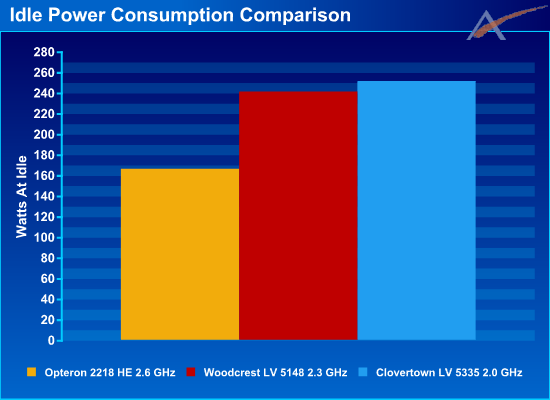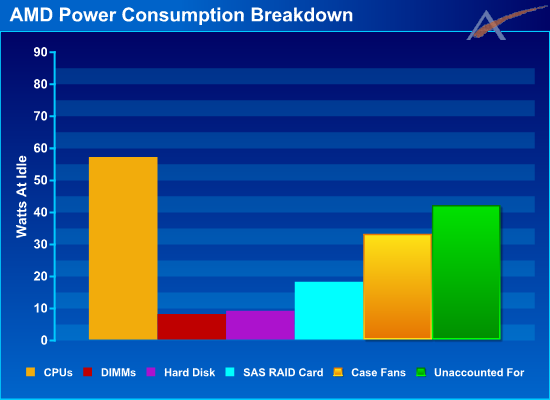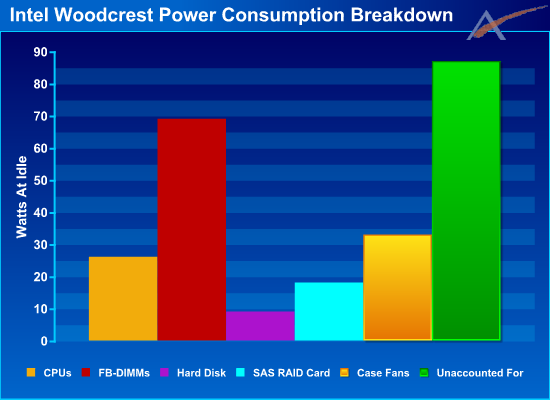Low Power Server CPU Redux: Quad-Core Comes to Play
by Jason Clark & Ross Whitehead on September 13, 2007 6:05 AM EST- Posted in
- IT Computing
Benchmarking Low Voltage
Since this article is focused on low power parts and that market is mostly focused on Performance/Watt, we decided we would only report results with all power management features enabled. To configure our servers with all power management features on, we perform the following:
On Intel
In the BIOS ensure that Thermal Management is On/Enabled, C1 Enhanced Mode is On/Enabled, and EIST Support is On/Enabled.
On AMD
In the BIOS ensure that PowerNow is On/Enabled. Additionally, you must install the Processor Driver, from AMD, in your OS.
For both platforms you must also set the Power Options in Control Panel to "Server Balanced Processor Power and Performance".
For details about the impact that the Power Management features had on a system at idle please see our previous article. With all Power Management features turned on we recorded idle power usage for all three systems.

We see that AMD has the lowest idle power consumption. Intel's Woodcrest system uses approximately 41% more power at idle, and the Clovertown system uses approximately 51% more power at idle. The Clovertown system only uses approximately 4% more power at idle than the Woodcrest system, which is not bad considering it has twice as many CPU cores.
During the testing, we often speculate about where all the power goes. We attempted to find out by measuring power consumption of the entire system at idle, then removing a component and re-measuring the power consumption. The difference in power can be attributed to the removed component. This is not a perfect way to determine component power requirements, but it does provide some general guidance as to where all of the power goes. The results are very interesting:

In the AMD system we see that the bulk of the power is consumed by the idle CPUs. Overlooking the "Unaccounted For", the next biggest consumer is the five case fans, followed by the SAS RAID Card. The "Unaccounted For" is everything which is not listed, including the inefficiency of the power supply and the motherboard and chipset.

In the Intel Woodcrest system we see that the CPUs require significantly less power than the AMD CPUs, 54% less to be exact. On the other hand the FB-DIMMs require 862% more power than the AMD DIMMs. (Yikes!) Also, the "Unaccounted For" is twice as high on the Intel system as the AMD system. Keep in mind both of these systems have identical power supplies, so the efficiency is roughly the same.

The Intel Clovertown system is identical to the Woodcrest system except for the CPUs, which require approximately 4% more power at idle.
Choosing the contenders
In previous articles, we've been asked to explain why we chose the parts we did for an article. For this article we used the latest low voltage quad-core parts from Intel and the latest low power dual-core parts from AMD. The first question that may come to mind is, "Why are you comparing a quad-core part with a dual-core part?". The answer is quite simple: for Intel the two quad-core / dual-core parts we're comparing cost about the same, so while the parts we are comparing aren't equal in terms of the number of Cores, they are equal in terms of price. On the AMD side of things, the CPU price is once again similar, but other than the just-released Barcelona there are no quad-core AMD offerings. Since testing for this article began over a month ago, including Barcelona wasn't an option at the time.
Since this article is focused on low power parts and that market is mostly focused on Performance/Watt, we decided we would only report results with all power management features enabled. To configure our servers with all power management features on, we perform the following:
On Intel
In the BIOS ensure that Thermal Management is On/Enabled, C1 Enhanced Mode is On/Enabled, and EIST Support is On/Enabled.
On AMD
In the BIOS ensure that PowerNow is On/Enabled. Additionally, you must install the Processor Driver, from AMD, in your OS.
For both platforms you must also set the Power Options in Control Panel to "Server Balanced Processor Power and Performance".
For details about the impact that the Power Management features had on a system at idle please see our previous article. With all Power Management features turned on we recorded idle power usage for all three systems.

We see that AMD has the lowest idle power consumption. Intel's Woodcrest system uses approximately 41% more power at idle, and the Clovertown system uses approximately 51% more power at idle. The Clovertown system only uses approximately 4% more power at idle than the Woodcrest system, which is not bad considering it has twice as many CPU cores.
During the testing, we often speculate about where all the power goes. We attempted to find out by measuring power consumption of the entire system at idle, then removing a component and re-measuring the power consumption. The difference in power can be attributed to the removed component. This is not a perfect way to determine component power requirements, but it does provide some general guidance as to where all of the power goes. The results are very interesting:

In the AMD system we see that the bulk of the power is consumed by the idle CPUs. Overlooking the "Unaccounted For", the next biggest consumer is the five case fans, followed by the SAS RAID Card. The "Unaccounted For" is everything which is not listed, including the inefficiency of the power supply and the motherboard and chipset.

In the Intel Woodcrest system we see that the CPUs require significantly less power than the AMD CPUs, 54% less to be exact. On the other hand the FB-DIMMs require 862% more power than the AMD DIMMs. (Yikes!) Also, the "Unaccounted For" is twice as high on the Intel system as the AMD system. Keep in mind both of these systems have identical power supplies, so the efficiency is roughly the same.

The Intel Clovertown system is identical to the Woodcrest system except for the CPUs, which require approximately 4% more power at idle.
Choosing the contenders
In previous articles, we've been asked to explain why we chose the parts we did for an article. For this article we used the latest low voltage quad-core parts from Intel and the latest low power dual-core parts from AMD. The first question that may come to mind is, "Why are you comparing a quad-core part with a dual-core part?". The answer is quite simple: for Intel the two quad-core / dual-core parts we're comparing cost about the same, so while the parts we are comparing aren't equal in terms of the number of Cores, they are equal in terms of price. On the AMD side of things, the CPU price is once again similar, but other than the just-released Barcelona there are no quad-core AMD offerings. Since testing for this article began over a month ago, including Barcelona wasn't an option at the time.










36 Comments
View All Comments
coolme - Monday, September 17, 2007 - link
sorry, I meant MCM.Frags - Saturday, September 15, 2007 - link
AMD has had ample time to scale their processor to a winning choice. MCM was the smartest choice as Intel was bringing in money over the year as AMD showed no competition. Even though Barcelona is still coming (Don't act like it's here already.) AMD is still losing money.Even AMD said themselves they wish they had come out with an MCM design with Intel. Unfortunately since they are behind on processor technology it wouldn't have been feasible.
Even you have said "small, but significant advantage" in other words an advantage that is way too late because they took the long route to revenue. With such a large die size, I can see that yields will still remain low til Intel comes out with definitive competitive beast in very high yields and wide avaiablity. So from a business point of view, AMD is failing. If AMD cannot cut Intels technology lead by half a year, we will continue to see this trend til there is no more AMD.
Justin Case - Sunday, September 16, 2007 - link
Intel's manufacturing lead has been pretty much constant for a decade (if anything, the gap is slightly smaller now).AMD has a much bigger market share today than they did in the K7 (and K6, etc.) days. Add the fact that AMD now has some of the best GPUs in the market, a lot of very important patents, an excellent team of engineers and deals with most top OEMs (all things they didn't have back then), and it's pretty obvious that news of AMD's death are greatly exaggerated.
The problem with AMD is they're trying to grow too fast. To sustain their current growth rate, they're going to have to start turning in a profit very soon (as in under 5 months), which is not very likely.
If AMD manages to ramp Barcelona to, say, 2.6 GHz in volume until the end of the year (which is not impossible; the issue is related to a respin, not progressive improvement), then the risks they've been taking probably will pay off. Otherwise they'll be forced to slow down and compete based on price, at least until Bulldozer is ready. Their latest GPUs are looking pretty good, too, so they might be able to get by on profits from the ATI division even if Barcelona takes longer to ramp (as I suspect it will).
In any case, this idea that some people seem to have that AMD is "ruined" and "about to disappear" is complete nonsense. They're in a much better position today than they were in 2002, and they didn't disappear in 2002, either.
P.S. - A dual-die (2+2) CPU would have been perfectly feasible (just slap a second core on the same package, connected by HT, and treat is as a RAM-less CPU one hop away), and AMD would have easily been able to release it before Intel. It was an executive decision not to do so, and one that I'm sure they regret. The market for quad-core CPUs is small but pretty lucrative. They were probably hoping to have Barcelona out ahead of schedule, and instead it got delayed (hardly something new, chez AMD). On the other hand, I'm sure they're glad they did not go with FB-DIMM (despite having licensed the patents and planned to support it with Barcelona).
Brunnis - Friday, September 14, 2007 - link
That's not the point. The point is that Intel went with an MCM design and was therefore able to sell quads for almost a year before AMD could provide any competition. Intel made a good decision and just because AMD finally have something to compete with, doesn't make that decision go from good to bad in the blink of an eye. It almost seems as if you believe the tested Intel quad core is a new product. It's not, it's still the old Clovertown core, although it's based on the newer G stepping.
Proteusza - Friday, September 14, 2007 - link
I think thats exactly the point. yes Intel had the overrall performance lead for over a year with their Core 2 architecture.And even now, they hold the top spot until Barcelona scales to higher clocks.
but, in a performance per watt race, they no longer hold the top spot because they no longer have the only quad core cpu.
Saying that Intel made the right decision in rushing a quad core to market is true. But it only holds true while AMD doesnt have its own quad core. When AMD does, it doesnt really matter who came first - it matters who offers better performance per watt.
Therefore, now that AMD has quad core chips out, it doesnt matter what Intel did to get theirs out first, it matters which is the best chip.. The Radeon X1950 has been out for longer than the 8800 GTS, does taht mean it is a better graphics card?
Pull Up Banners - Wednesday, May 4, 2011 - link
I am sure Anandtech know very well about these banners and hopefull will avoid all the advertising banners.Thanks,
<a href="ttp://www.ultimatebanners.co.uk/pull-up-banners.htm">Pull Up Banners</a>